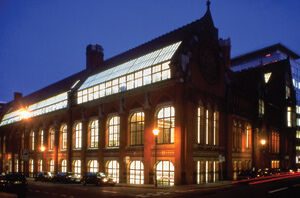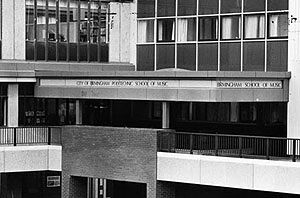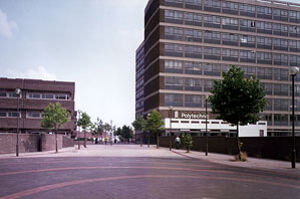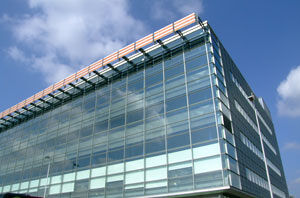Our History
Beginnings 1843-1971
 Our early history can be traced back to the five individual colleges which would be brought together as The City of ̽��ֱ�� Polytechnic in 1971.
Our early history can be traced back to the five individual colleges which would be brought together as The City of ̽��ֱ�� Polytechnic in 1971.
̽��ֱ�� College of Art has its roots back in October 1843, when the ̽��ֱ�� Society of Artists opened the ̽��ֱ�� Government School of Design. In 1884 the School evolved into ̽��ֱ�� College of Art, moving to a beautiful purpose-built Venetian Gothic building on Margaret Street designed by John Chamberlain. Today Margaret Street, which still houses our Department of Art, is a Grade I Listed Building.
In 1888 ̽��ֱ�� School of Jewellery, which was based in Ellen Street, became a branch of the College of Art. Two years later a new building was opened in Vittoria Street which has been the School's home ever since.
The School of Architecture was established within the College of Art in 1909 and won Royal Institute of British Architects (RIBA) recognition in 1923 and 1930 to become one of the UK’s major schools of architecture. On entry into the Polytechnic, the School became a leading department of the Faculty of the Built Environment.
̽��ֱ�� School of Music developed as a department of the ̽��ֱ�� and Midland Institute around 1859. The first phase of the present building in Paradise Circus was opened in 1973 by HM The Queen Mother.
 ̽��ֱ�� College of Commerce was established in the early 20th century and became a branch of ̽��ֱ�� Central Technical College (CTC) with its main teaching centre in Edmund Street. A new CTC at Gosta Green was formally opened by HM The Queen in 1955 and the College of Commerce moved to the site in the early 1960s. In 1961, the CTC’s technology divisions became the UK's first College of Advanced Technology which, in 1966, became Aston University. The College of Commerce remained separate, however, before becoming part of the Polytechnic.
̽��ֱ�� College of Commerce was established in the early 20th century and became a branch of ̽��ֱ�� Central Technical College (CTC) with its main teaching centre in Edmund Street. A new CTC at Gosta Green was formally opened by HM The Queen in 1955 and the College of Commerce moved to the site in the early 1960s. In 1961, the CTC’s technology divisions became the UK's first College of Advanced Technology which, in 1966, became Aston University. The College of Commerce remained separate, however, before becoming part of the Polytechnic.
South ̽��ֱ�� Technical College opened in 1961 on Bristol Road. In the early 1970s, the College's departments moved to new buildings in Perry Barr and the South ̽��ֱ�� site was later occupied by Bournville College of Further Education until 2011.
North ̽��ֱ�� Technical College was created in 1966 when Aston Technical College moved to new premises at Perry Barr. New buildings for the college formed part of the University's City North Campus until 2018.
̽��ֱ�� Polytechnic 1971-1988
 The City of ̽��ֱ�� Polytechnic was designated in 1971 by then Education Secretary Margaret Thatcher.
The City of ̽��ֱ�� Polytechnic was designated in 1971 by then Education Secretary Margaret Thatcher.
In 1975 a further three colleges were incorporated into the Polytechnic – Anstey College of Physical Education, Bordesley College of Education and City of ̽��ֱ�� College of Education.
Bournville College of Art, which was founded in the early 1900s, merged with the Faculty of Art and Design in 1988 to create the ̽��ֱ�� Institute of Art and Design. In 2014, it became a part of the .
Incorporation and independence 1989-1992
Since its designation in 1971, ̽��ֱ�� Polytechnic had been part of ̽��ֱ�� LEA's provision. However, on 1 April 1989 the Education Reform Act made all polytechnics independent corporations with charitable status.
The same year saw ̽��ֱ�� School of Music being renamed ̽��ֱ�� Conservatoire, with Sir Simon Rattle as the Conservatoire's first President.
University status 1992
 On 6 March 1992, the Further and Higher Education Act gave all polytechnics the power to adopt the title of 'university'. The new name, 'University of Central England in ̽��ֱ��', was approved by the Privy Council on 16 June 1992.
On 6 March 1992, the Further and Higher Education Act gave all polytechnics the power to adopt the title of 'university'. The new name, 'University of Central England in ̽��ֱ��', was approved by the Privy Council on 16 June 1992.
Also in 1992, work commenced on a new building for the ̽��ֱ�� School of Jewellery, which was opened formally in March 1995 and is the largest School of Jewellery in Europe.
During the summer of 1995 the University merged with the ̽��ֱ�� and Solihull College of Nursing and Midwifery, and the West Midlands School of Radiography.
In 2000, the Technology Innovation Centre (TIC) was created from the former Faculty of Engineering and Computer Technology. The next year it moved to the new Millennium Point campus and the Faculty of Education took up TIC's old premises at Perry Barr. TIC was later renamed the Faculty of Technology, Engineering and the Environment and then, in 2014, the Faculty of Computing, Engineering and the Built Environment.
In 2001, The Defence School of Health Care Studies joined the Faculty of Health. Working with the , the School is the sole provider of Pre-Registration Education in nursing, operating department practice and radiography for the Defence Medical Services in the UK.
̽��ֱ�� School of Acting, which was founded in 1936, became part of the University in 2005, and a year later moved to a purpose-built facility at Millennium Point.
Becoming ̽��ֱ��
In 2007, the University changed its name to ̽��ֱ�� and received a new logo, a reworking of the tiger crest used by the University of Central England in ̽��ֱ��, which itself originally came from the ̽��ֱ�� College of Commerce, one of the Polytechnic's founder institutions.
From 2011, the University has undertaken a major investment in its estates and facilities to create a campus fit for the future. The City Centre Campus has seen three major new developments – the Parkside Building for Design and Media students opened in 2013; the Curzon Building, which houses Business, Law and Social Science courses as well as new library, IT and student support facilities opened in 2015; and our new music building for the Royal ̽��ֱ�� Conservatoire opened in 2017. A new extension to our City South Campus to house Education, Sport and Life Science courses opened in 2018.
Previous names and predecessor institutions
This is a list of the former names of the University and some of the institutions that – over the years – have merged into the University:
- University of Central England in ̽��ֱ��
- ̽��ֱ�� Polytechnic
- ̽��ֱ�� College of Art
- ̽��ֱ�� School of Music
(now ̽��ֱ�� Conservatoire) - ̽��ֱ�� College of Commerce
- South ̽��ֱ�� Technical College
- North ̽��ֱ�� Technical College
- Anstey College of Physical Education
- Bordesley College of Education
- City of ̽��ֱ�� College of Education
- Bournville College of Art
- ̽��ֱ�� and Solihull College of Nursing and Midwifery
- West Midlands School of Radiography
- Defence School of Health Care Studies
- ̽��ֱ�� School of Acting.